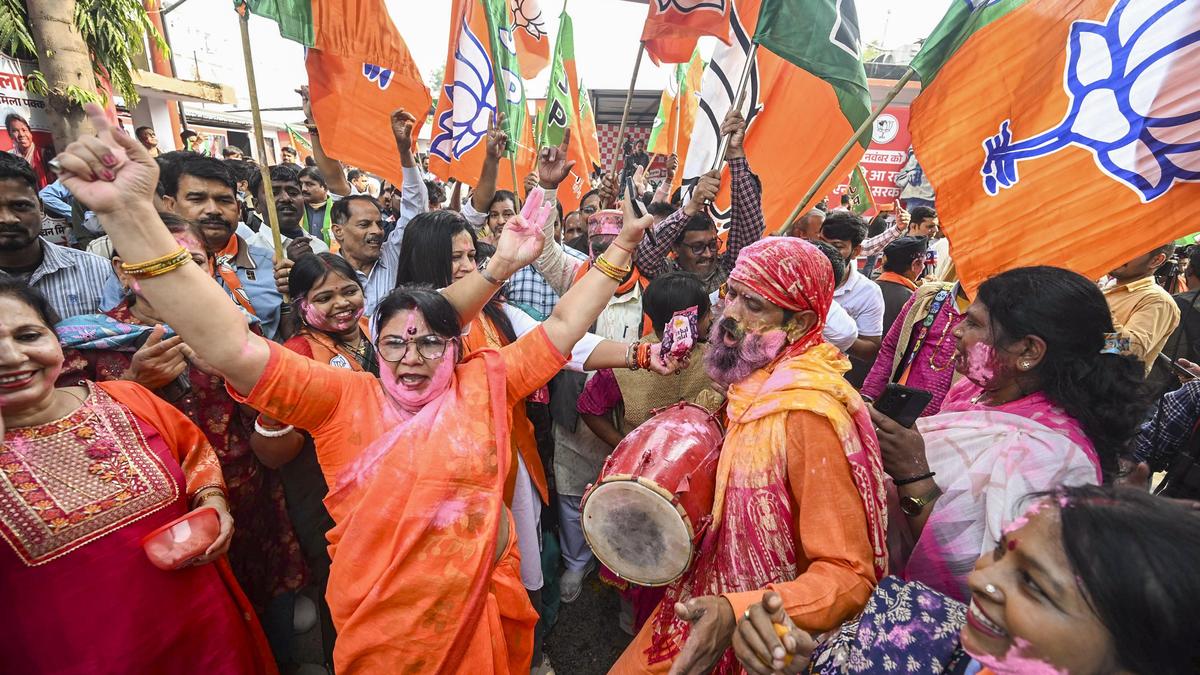How alliance consolidation, vote fragmentation gave the NDA a landslide win in Bihar

The National Democratic Alliance’s (NDA) sweeping victory in the Bihar Assembly elections, securing over 200 of the 243 seats, represents more than just electoral dominance: it exemplifies how India’s first-past-the-post system can magnify vote share advantages when party systems consolidate around two principal alliances.
The arithmetic tells a compelling story. The NDA secured 47.2% of the vote while the Mahagathbandhan (MGB) obtained 37.3%, a gap of nearly 10 percentage points. While significant, this margin alone doesn’t fully explain the NDA’s bumper harvest of seats. The answer lies in the structural transformation of Bihar’s party system over the past decade.

The vote consolidation story
The MGB’s performance reveals a curious stagnation. Despite incorporating smaller parties such as the Vikassheel Insaan Party (VIP), targeting the Mallah community, and the Indian Inclusive Party, aimed at the Tanti-Paan community (listed among the Extremely Backward Classes), the alliance could not improve upon its 2020 vote share of 37.23%. The promised arithmetic of caste-based mobilisation failed to translate into additional votes.
In contrast, the NDA registered a remarkable surge, increasing its vote share by nearly 10 percentage points. This was largely driven by the return of the Lok Janshakti Party (Ram Vilas) to the NDA fold, which alone contributed 5.5% of the votes. Additionally, the Bharatiya Janata Party and Janata Dal (United) each expanded their vote shares by 1.5 and 3 percentage points respectively.
The JD(U)’s gains merit particular attention. The party benefited from two reinforcing factors: transferable votes from LJP (RV) supporters, which in 2020 had fielded candidates exclusively against JD(U) nominees under Chirag Paswan’s leadership, and a surge in women voters, many of whom favoured the party, likely influenced by its welfare schemes targeted at women.
From fragmentation to bipolarity
Bihar’s political landscape has historically been characterised by fragmentation, with multiple parties competing vigorously across constituencies. An examination of the average Effective Number of Parties (ENOP) across Assembly and Lok Sabha elections through 2015 reveals consistently high fragmentation, with ENOP values exceeding 3. This meant that vote shares translated inefficiently into seat shares, as votes were dispersed across multiple contestants.
A decisive shift began with the 2019 Lok Sabha elections, when the consolidation of Bihar’s political forces into two principal alliances, the NDA and the MGB, dramatically reduced fragmentation. The ENOP dropped to 2.58, signalling the emergence of a bipolar contest. The 2020 Assembly elections appeared to reverse this trend, with ENOP rising to 3.34, but this was an aberration caused by LJP’s decision to contest separately against JD(U) candidates.
The 2024 Lok Sabha elections demonstrated the electoral potency of consolidated alliances. With LJP (RV) back in the NDA fold and facing the same alliance structure that would persist into 2025, the ENOP fell to 2.41. The NDA reaped the benefits of this consolidation, dominating in Assembly segments across the state.
The 2025 Assembly elections maintained this bipolar structure, though with a slight increase in fragmentation (ENOP of 2.65) due to the entry of Prashant Kishor’s Jan Suraaj Party (JSP). However, rather than challenge the NDA, JSP appears to have drawn votes primarily from the anti-incumbency pool.
The spoiler effect
The JSP’s performance proved decisive in shaping the final outcome. Securing 3.5% of the vote, the party—along with the All India Majlis-e-Ittehadul Muslimeen—split the anti-incumbency vote. The MGB’s vote share declined from the 40.1% it registered in the 2024 Lok Sabha elections to 37.3% in 2025, a drop of 2.8 percentage points, closely mirroring the JSP’s vote share.

In a fragmented party system, such vote splits might have limited consequences. But in a bipolar contest operating under first-past-the-post rules, even small vote share differences translate into disproportionate seat gains for the leading alliance.
The mechanics of electoral translation
Again, India’s electoral system rewards concentrated vote shares in bipolar contests. When the party system features only two major alternatives, the leading alliance doesn’t merely win more seats: it often sweeps constituencies. The NDA’s 10-percentage-point advantage, operating in a political environment where the ENOP has fallen below 3, created the conditions for its landslide.
This is the fundamental arithmetic that delivered the NDA’s triumph: a combination of alliance consolidation, which concentrated anti-establishment votes within the MGB, and the strategic fragmentation of that opposition vote by the JSP and AIMIM, which prevented the MGB from capitalising fully on anti-incumbency sentiment.
The NDA has built a more diverse coalition based on caste identities: The BJP has consolidated its support among the upper castes. The JD(U) stitched together support from the EBCs, non-Yadav OBCs, and “Mahadalits” besides targeting women as a category. The LJP(RV) catered to the Pasi and other Dalit communities, while smaller parties attracted votes from the Dalit and Koeri communities. The MGB’s counter mobilisation — the RJD’s Yadav-Muslim base, and the Congress’ and the Left’s eclectic support — was not numerically enough to overcome this.

Published – November 14, 2025 03:20 pm IST





